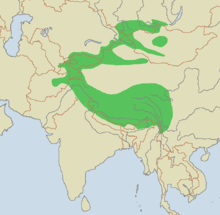| Snow leopard | |
|---|---|
 | |
| Conservation status | |
| Scientific classification | |
| Kingdom: | Animalia |
| Phylum: | Chordata |
| Class: | Mammalia |
| Order: | Carnivora |
| Family: | Felidae |
| Subfamily: | Pantherinae |
| Genus: | Uncia (disputed) Gray, 1854 [2] |
| Species: | U. uncia |
| Binomial name | |
| Uncia uncia (Schreber, 1775) | |
| subspecies | |
 | |
| Range map | |
| Synonyms | |
The snow leopard (Panthera uncia or Uncia uncia) is a moderately large cat native to the mountain ranges of Central Asia. The classification of this species has been subject to change and is still classified as Uncia uncia by MSW3 as of 2000[4] and CITES Appendix I[5]. However with more recent genetic studies[6][7] the snow leopard is now generally considered as Panthera uncia and classified as such by IUCN[8]. Classically, two subspecies have been attributed however genetic differences between the two have not been settled. The snow leopard remains on the endangered species list classified as C1.[9]
Snow leopards occupy alpine and subalpine areas generally 3,350 and 6,700 metres (10,990 and 22,000 ft)[10] above sea level in Central Asia. The Snow Leopard Survival Strategy (McCarthy et al. 2003, Table II) compiled national snow leopard population estimates, updating the work of Fox (1994). Many of the estimates are acknowledged to be rough and out of date, but the total estimated population is 4,080-6,590.[11]However, the global snow leopard effective population size (those likely to reproduce) is suspected to be fewer than 2,500 (50% of the total population, or 2,040-3,295).[12]
Snow leopards are smaller than the other big cats but, like them, exhibit a range of sizes, generally weighing between 27 and 55 kg (60 and 120 lb), with an occasional large male reaching 75 kg (170 lb) and small female of under 25 kg (55 lb).[13][14] Body length ranges from 75 to 130 centimetres (30 to 50 in), with the tail adding a further 80 to 100 cm (31 to 39 in) to that length.[15][16] These cats stand about 60 cm (24 in) at the shoulder.[17]
Snow leopards have long thick fur, and their base color varies from smoky gray to yellowish tan, with whitish underparts. They have dark gray to black open rosettes on their body with small spots of the same color on their heads and larger spots on their legs and tail. Unusually among cats, their eyes are pale green or gray in color.[15][16]
Snow leopards show several adaptations for living in a cold mountainous environment. Their bodies are stocky, their fur is thick, and their ears are small and rounded, all of which help to minimize heat loss. Their paws are wide, which distributes their weight better for walking on snow, and have fur on their undersides to increase their grip on steep and unstable surfaces; it also helps to minimize heat loss. Snow leopards' tails are long and flexible, helping them to maintain their balance, which is very important in the rocky terrain they inhabit. Their tails are also very thick due to storage of fats and are very thickly covered with fur which allows them to be used like a blanket to protect their faces when asleep.[16][18]
The snow leopard has a short muzzle and domed forehead, containing unusual large nasal cavities that help the animal breathe the thin, cold air of their mountainous environment.[15]
The snow leopard cannot roar, despite possessing partial ossification of the hyoid bone. This partial ossification was previously thought to be essential for allowing the big cats to roar, but new studies show that the ability to roar is due to other morphological features, especially of thelarynx, which are absent in the snow leopard.[19][20] Snow leopard vocalizations include hisses, chuffing, mews, growls, and wailing.
The snow leopards are also about to be extinct people kill them for their skin we must stop this.

No comments:
Post a Comment